What Shape Is Your Butt? Learn the 6 Different Butt Shapes
Explore various butt shapes and find tailored workouts for your unique form. From heart-shaped to round, learn about diverse butt shapes.
How often do you think about your butt shape?
Humans come in all shapes in sizes, and that includes our derrieres. You might be intimately familiar with your own booty (at least, we hope so!), but do you have a working knowledge of the different forms human buttocks can take on?
This glute guide will provide a comprehensive look into why your tush looks the way it does. Plus, explore targeted workouts for each butt shape.
Find out how to build the best butt to suit your anatomy and get the lowdown on how the gluteal muscles operate in your body.
How to Get a Healthy Butt
Here, we’ll go into more detail about the different shapes your butt can take on.
First, what makes the butt healthy?
You may prefer the look of a butt made of solid muscle. We all have our personal preferences on size, shape, and firmness when it comes to our butts.
But did you know that certain types of butts may be better to have for your health?
It can be healthier to hold fat in the gluteofemoral area (butt and thighs). Fat here, rather than the abdominal area may put you at lower cardiovascular risk.
Typically, women carry more fat than men overall. This can vary with body estrogen levels and age. Women of childbearing age usually have more fat around the hips which can help the process of childbirth.
It’s important to differentiate between subcutaneous fat and visceral fat. Subcutaneous fat is stored as a layer just beneath the skin, while visceral fat is distributed among the organs and sits more deeply inside the body.
Now that you’re familiar with how fat distribution works in regards to the glute area, let’s take a moment to learn more about the gluteal muscles.
What Are the Butt Muscles?
Here, we’ll go through an overview of which muscles are hard at work when you focus on working out your glutes.
The “butt muscles,” aka gluteal muscles are composed of three parts:
1. Gluteus Maximus: We often say “gluteus maximus” and “butt” interchangeably, but this muscle is only one part of the equation. The gluteus maximus is the biggest of your three gluteal muscles.
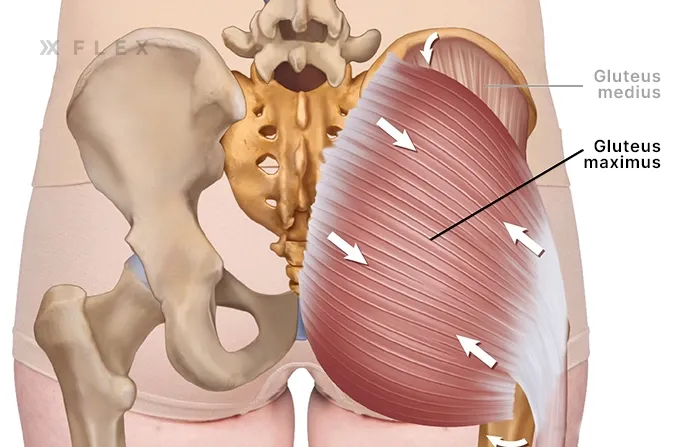
This muscle extends your hips (moving the thigh backward in space). It is also partially responsible for the external rotation of your hip joints. When you turn your feet and hips out, the gluteus maximus helps power this movement.
Located at the back and center of your butt, your gluteus maximus helps give your buttocks a rounded shape. For a heart-shaped butt, working the gluteus maximus is key to developing butt volume. Glute dumbbell exercises and squats are great to help you develop this muscle.
2. Gluteus Medius: This muscle is located on the outer side of your pelvis, along the back hip. The gluteus medius muscle helps with hip abduction (moving your thighs away from the midline of your body). It is also a key player in pelvic stability.
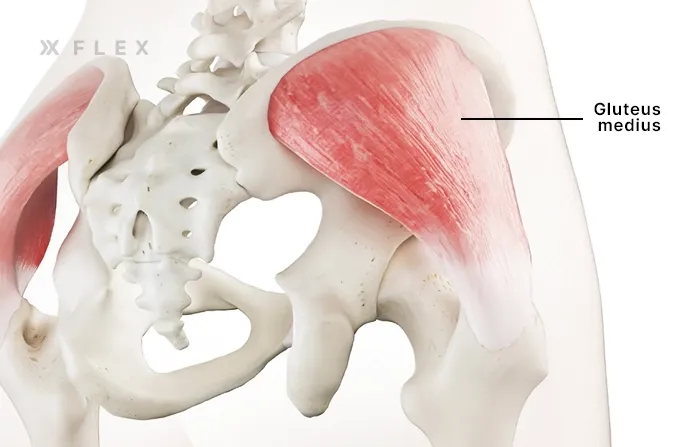
3. Gluteus Minimus: The smallest muscle of the trio, this gluteal muscle lives under the gluteus medius. Your gluteus minimus helps with hip abduction. It also stabilizes your joints. You can work on gluteus minimus exercises like hip abduction to target this muscle. This helps you to get a more rounded out look along the sides of your glutes.

All of the gluteal muscles help drive power, strength, and stability in your body. Think about it: many of the key moves humans perform in the gym or functionally in everyday life are driven from the seat.
For example, you’ve probably heard “lift with your legs” to avoid back injuries. Maybe you’ve oh, you know, left your house and gone for a walk?
Even many of the simplest movements that we do without thinking. Therefore, it’s important to keep strong gluteal muscles for total lower body strength. You’ll improve your balance and posture and diminish injury risk.
Glute-focused workouts like hip thrusts and glute bridges) can be great in strengthening the gluteal muscles. Big compound lifts like your squats and deadlifts are also mega glute strengtheners. These help your posterior chain.
Additionally, activities like running, cycling, and climbing stairs also engage the glutes. It's important to maintain a balanced workout routine that targets different muscle groups to promote overall strength and prevent imbalances.

Butt Shapes
Now, let’s explore a few of the common shapes that human butts can take on. Take a look through these booty types and see if you can find yours.
Heart-Shaped Butt
It’s more of an upside-down heart, but the heart-shaped butt is one of the most coveted butt shapes in the world.
The heart-shaped butt is widest at the base, where it attaches to your legs and tapers in as it rises to meet your waist.
Especially for women, the heart-shaped butt is a popular goal. Think of Kim Kardashian’s notorious assets and you’ll see someone with an example of a heart-shaped butt.
Although you may not be Kim, you can certainly optimize your workouts with great exercise to try to work towards a similar butt shape.

Round Butt
A round butt, aka bubble butt, is the most proportionate overall. This butt has even fat distribution along the top, bottom, and sides of the hips, as well as on the butt cheeks. A round butt is something many strive for.
How to get a round butt depends on several factors, including gender and genetics. Although men may not have as much booty fixation as women when it comes to workouts, it’s still a good idea to tone up. A rounded butt can look great on anyone!
After all, it’s more visually pleasing than a pancake butt, right? What’s more, it feels great to have strong butt muscles, so a round butt is one both men and women may want to work towards in the gym.
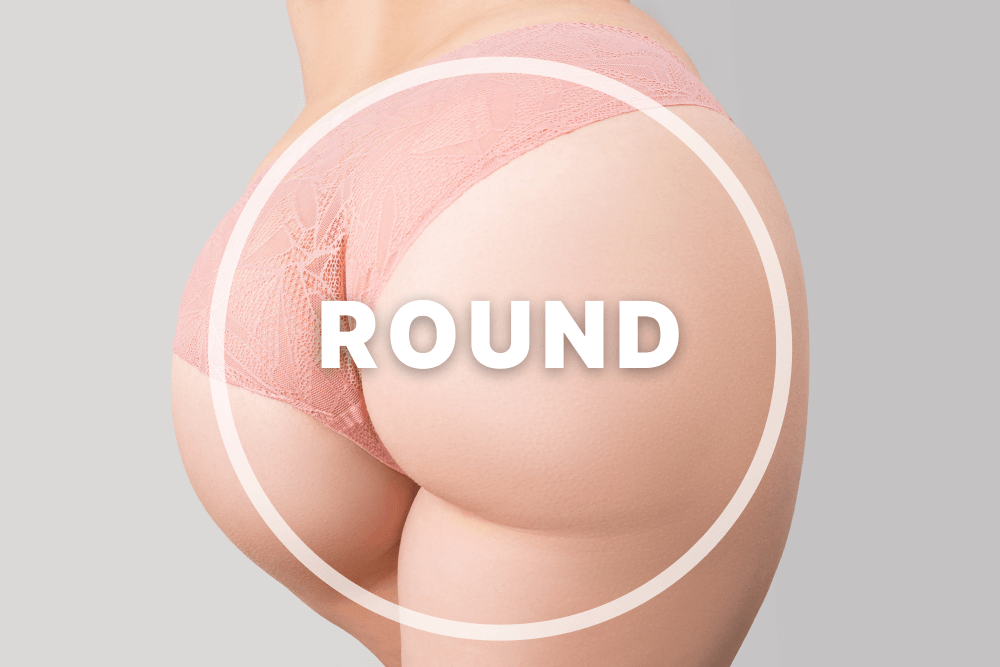
Square Butt
We sometimes call a square butt an H-shaped butt and it looks like how it sounds. Square butts have more linear sides and don’t round out through the sides.
A square butt has more volume up top but flattens at the base.
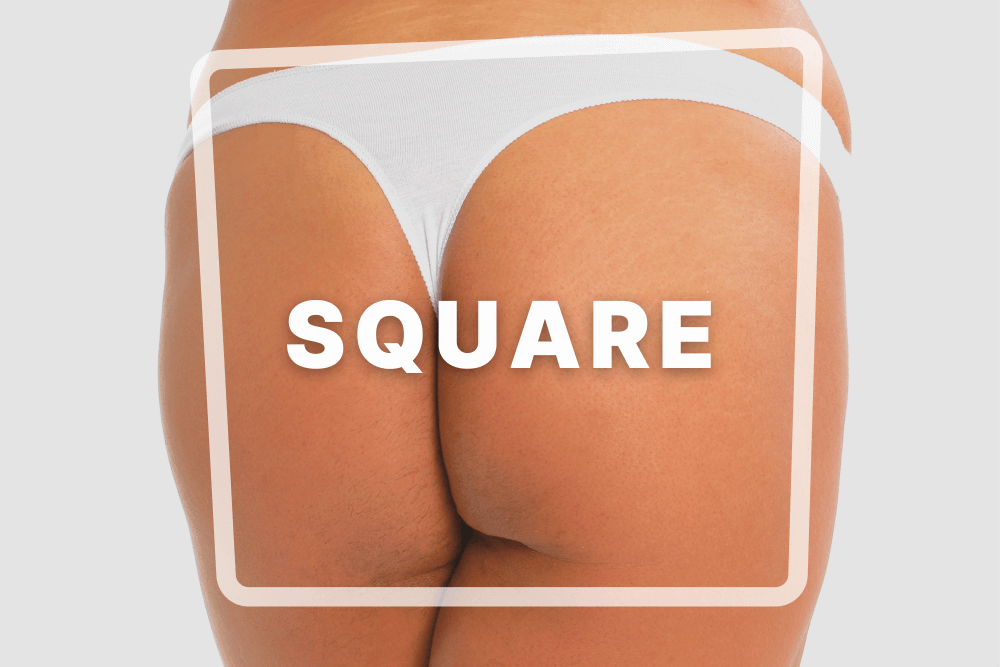
If you’ve ever experienced the “muffin top,” aka, spilling out of your low-cut jeans, you may have a square butt.
Fortunately, if you’re looking for the best exercises to turn your square butt into a round behind, we’ve got some tips coming up, so stay tuned.
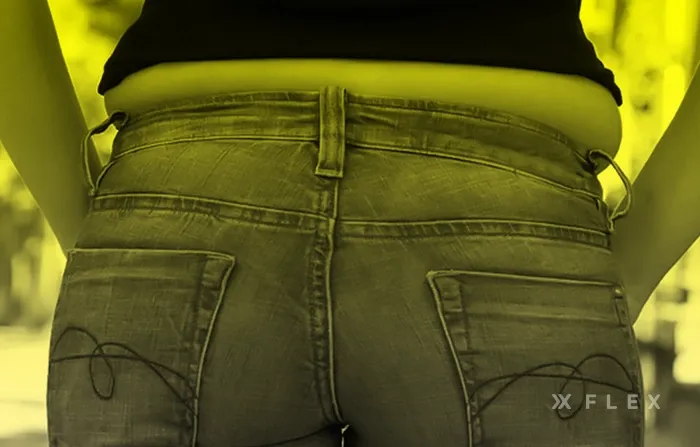
Inverted Butt
Inverted butts, like squares, carry a lot of volume up top. They’re also referred to as V-shaped butts.
These butts, though, have even less fat and muscle distribution around the base of the butt, resulting in smaller or flatter cheeks.
Although all booties are beauties, you may need to focus a bit more on powering the biggest butt muscle— the gluteus maximus. This will give you more development through your rear and lower butt to round out that shape.
Everyone’s booty is unique. Your butt might have a combination of different ASStributes and fall into more than one category.
For instance, you could be mainly a square. But by developing the gluteus maximus, your butt can take on a round appearance, even if you have narrow hips.
If you want to turn your V-shaped glutes round, read on for some workouts that will help you develop the sides and bottom of your… bottom for a more even, rounded-out shape.
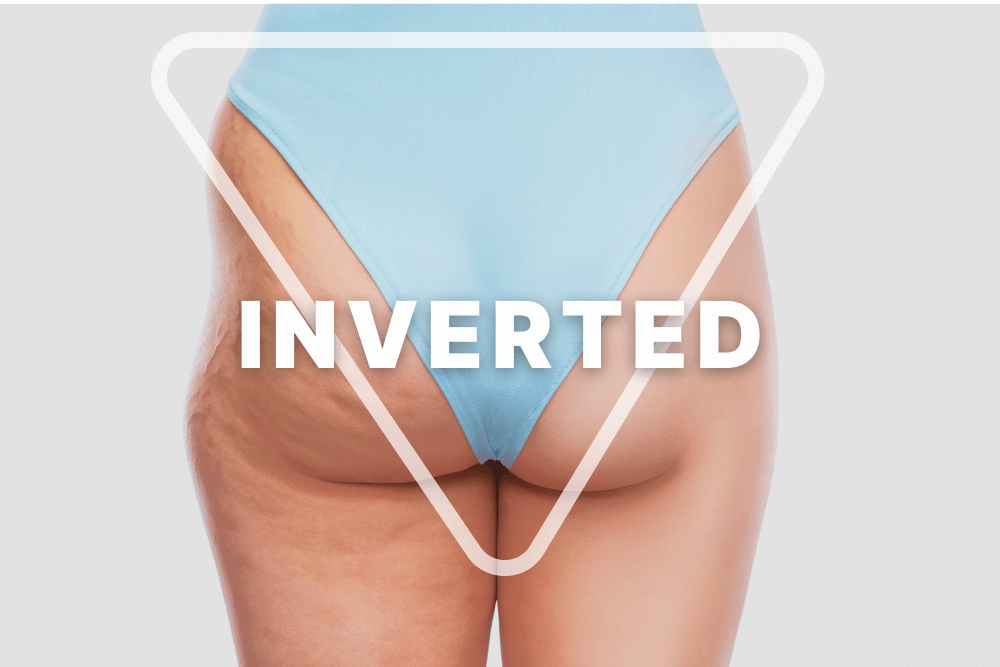
Shelf Butt
It’s all in the name! A shelf butt has the type of shape you could stack a pile of books or glass of water on top of.
The shelf butt shape protrudes so strongly that the glutes almost make a perpendicular shape to your back.
Although many shelf shapes are achieved with butt augmentation (aka BBLs, which are rapidly on the rise), it’s possible to work towards some very ample assets yourself by tuning up your diet and hitting the gym.

The shelf butt is named because, like a shelf that you mount on your wall, this butt is so prominent it could balance things on it.
If you like big butts and you cannot lie, the shelf is one of the best shapes you can aim for, besides the heart-shaped butt or round butt.
Most of us are not that genetically blessed with strong enough upper glutes to form a shelf. This butt shape is harder to come by naturally. Your sacral slope, or the way your pelvis tilts, not only impacts your spinal health, but it impacts how your butt sits too.
A sacral slope that is considered in the “normal” range is −32° to −49°, or a tilt of your pelvis from 3° to 18°. A tilt or curve outside this range can indicate lumbar lordosis (an inward curve to your spine).
This condition has a strong genetic component and may hurt your back, but people with lordosis may have the appearance of bigger booties because of the way their spines curve naturally.
On the other hand, a condition called kyphosis causes your spine to curve the other way (outward), making you look hunched over with a rounded back.
Your pelvis tilts underneath you here, which may give the illusion of a smaller butt, even if your booty is muscular.
Although you can’t change the shape of your pelvis, most people can improve the shape of their butts through workouts and exercise.
Maybe a giant badonkadonk simply isn’t in the cards for you because of your genes. But focusing on glute-dominant workouts (we’ll come to a few later) can certainly help you work with what you’ve got.
Pancake Butt
If your tush looks flat or saggy, you may have a pancake butt. In this behind shape, the butt cheeks and lower glutes tend to meld together with the backs of your thighs.
Pancake butts lack of visible definition between the butt and the legs. They also tend to have more volume around the top, like an inverted butt. If you love baked goods, a lot is going on here!
This also creates a lack of distinction between waist and butt. So overall, this type of butt will not stick out much from your body to create shape.
You may have a pancake and a muffin top at the same time. Like on square butts, the muffin top effect can happen when excess abdominal fat spills over the waistband of your pants.
We tend to think of “skinny fat” people as having this butt type. But anyone can have a pancake butt, no matter if you’re lean or bulky.
Women are generally more proactive about seeking pancake butt solutions than men since having a great booty is more commonly a goal for women in the gym.
That being said, guys can benefit from some butt-shaping work too. Although it’s stereotyped as “feminine,” butt workouts are important to give you a balanced physique as a guy. So don’t be embarrassed, guys, you too can hit the abductor machine!
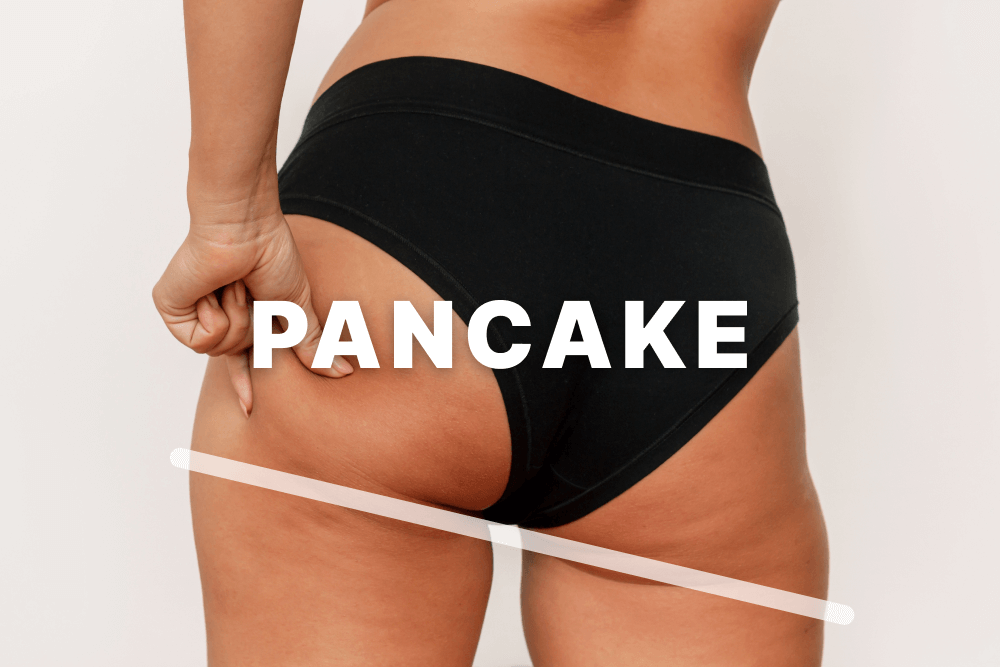
Butt Workout— Improve Your Shape
Okay, so hopefully you’re familiar with which butt shape coincides the most with your own.
But regardless of shape, how can we make those buttocks bigger, bouncier and better?
Here’s a glute guide to get your muscles firing. It’s a simple one, so if you’re looking for something beginner-friendly, this is a good place to start.
Each exercise targets the glutes and can be performed by beginners. Aim to complete the circuit, and repeat it 2-3 times with a short break between each exercise.
Bodyweight Squats
- Stand with feet shoulder-width apart.
- Lower your body by bending your knees and pushing your hips back as if you are sitting in a chair.
- Keep your chest up, and make sure your knees don't go beyond your toes.
- Stand back up, squeezing your glutes at the top.
- Repeat for 12-15 reps.
Hip Thrusts
- Find a flat weight bench and load a barbell with a heavyweight.
- Lean your back up against your weight bench. The bench should hit you at around your mid to upper back.
- Place the barbell over top of your hips, resting it on your pelvis near your hip bones. Use a mat or pad if this is painful for you.
- Bend your knees and plant both feet firmly on the floor.
- Your toes can point slightly outward. Make sure your knees are a comfortable enough distance away from you so that at the top of the move, your thighs will be parallel to the floor.
- Drive through your feet. Squeeze and engage your glutes and core and lift your hips towards the ceiling. Once your thighs line up with your torso, you’re at the proper angle.
- Slowly lower your hips back toward the floor, being careful to keep your leg muscles turned on and your core fully engaged as you lower. Continue for reps.
- For beginners, we recommend three to four sets of 8 to 10 reps.
Lunges
- Stand with feet together.
- Take a step forward with your right foot, lowering your body until both knees are bent at a 90-degree angle.
- Push off your right foot to return to the starting position.
- Repeat on the other leg.
- Continue alternating legs for 12-15 reps on each leg.
Glute Bridges
- Lie on your back with your knees bent and feet flat on the floor.
- Lift your hips towards the ceiling, squeezing your glutes at the top.
- Hold for a moment and then lower your hips back down.
- Repeat for 15 reps.
Donkey Kicks
- Start on your hands and knees in a tabletop position.
- Lift your right leg, keeping the knee bent at 90 degrees, and kick it towards the ceiling.
- Lower it back down without touching the floor and repeat.
- Perform 15 reps on each leg.
Side-Lying Leg Lifts
- Lie on your side with your legs extended.
- Lift your top leg towards the ceiling, engaging your outer hip.
- Lower it back down without letting it touch the bottom leg.
- Do 15 reps on each side.
Banded Hip Abduction
- Sit on a weight bench or box.
- Wrap a resistance band around your mid-thighs.
- Hold the sides of your weight bench for stability
- Plant your feet comfortably on the ground.
- Push your knees outward to send your hips away from your midline.
- Working against the tension of the band, bring your knees back to the starting position with control.
- The band should not be snapping or jerking your knees together.
- Repeat for as many reps as needed. We recommend 3 sets of 10 reps.
Gym Tips: Start SLOW. Use control for each of these exercises. Simple doesn’t always mean easy. While it can be tempting to start lifting heavy right away, it’s easy to hurt yourself if you don’t yet have proper training or technique.
Make sure you work safely through your muscles and range of motion to engage each muscle group effectively.
Squeezing your butt during these moves can make all the difference if you’re not feeling enough engagement right away. If a tight squeeze isn’t cutting it, that could be a sign that it’s time to up your weights (congrats!).
If any exercise feels too difficult, start with fewer reps. Gradually work your way up as you build strength. Consistency is key, so try to do this routine 2-3 times per week.
And make sure to alternate this butt routine with the upper body too! Yes, we like to make leg day skippers the BUTT of our jokes around here. But you’ll look just as imbalanced with a large lower half and nothing upstairs.
Diet for a Better Butt
Although exercise and genetics are crucial to getting the butt shape you want, diet too has a major role to play when it comes to determining your butt shape and size.
Whether you’re looking to get a bigger, rounder booty, or shed some pounds for a slim figure, getting your nutrition right when it comes to building your butt.
Here are a few nutritional considerations you’ll want to make when it comes to defining a better butt shape for you.
Healthy Fats
If you’re trying to gain volume in your glutes, consider incorporating some more foods rich in healthy fats into your diet. Omega-3 fatty acids are some of the best fats you can consume. You can find these in foods like:
- Salmon
- Sardines
- Cod liver oil
- Omega-enriched eggs
- Spinach
- Soybeans
- Flaxseeds
Omega-3s have several potential health benefits:
Heart Disease Risk: If you struggle with stubborn fat that is making your booty look bad, you may be at higher risk for conditions like heart disease. This is increasingly prevalent in people who are overweight or obese.
A diet high in omega-3 fatty acids can help you manage the risk of heart disease if you’re carrying too much abdominal fat near your butt.
Anti-Inflammatory: Fatty acids may also help reduce the risk of inflammation in the body. Evidence suggests that they help regulate the expression of cytokines, a type of protein associated with inflammation of the body.
Chronic inflammation is associated with things like weight gain, cancer, diabetes, and autoimmune disease. Although these health concerns make controlling your inflammation a must, aesthetically speaking, too much inflammation can make your booty look worse.
Muscle Building: Some research supports a correlation between omega-3 consumption and skeletal muscle strength and performance, especially in older populations.
Building up your muscle mass is one of the simplest ways to improve the shape of your derriere. Along with burning calories and reducing your unhealthy or excess fat consumption, this can have a hand in helping you build your dream butt.
Help You Sleep: One study found a correlation between those who consumed diets high in omega-rich fish and better sleep.
Building muscle and your body’s ability to reduce inflammation, are great ways to build not only a nicer butt, but a healthier, more muscular and lean body overall.
Lean Protein
Lean protein is one of the healthiest foods you can consume when it comes to improving the size and composition of your butt.
Getting enough protein is one of the best ways to tweak your diet for better overall health.
More protein is associated with boosting metabolism, lower blood cholesterol, and better ability to maintain a healthy weight.
If, for example, you have a square butt or a muffin top where you carry a lot of fat in your glutes, upping your protein can be a great way to improve the composition of your body.
Although you may think that fewer calories is the way to go here (which is true– to some extent you do need to burn fat to reduce excess fat) make sure you're getting the right type of calories in. Lean protein helps you make the gains you want.
Examples of lean proteins you can easily work into your diet include:
- Eggs
- Salmon or tuna fish
- Chicken or turkey
- Tofu
- Lean ground beef
- Beans
Add one or more of the following to your meals and (combined with your workouts) you should start seeing the booty building benefits.
Complex Carbohydrates
Healthy carbs are one of the best ways to keep your energy up during workouts. if you're heading the squat rack, working on your lunge technique, or giving those glutes a burn on the stairmaster, you'll need the energy to carry yourself through your workouts from start to finish.
Carbohydrates help to fuel your workouts and generate energy so that your body can perform the exercises you need it to.
Incorporate healthy carbs into your diet like:
- Brown rice
- Quinoa
- Sweet potatoes
- Fruits and vegetables
These powerful energy sources will help ensure you have the drive to make it from the beginning to the end of your workouts.
The Takeaway
We hope you learned a bit about butts!
To recap, your butt muscles consist of the gluteus maximus, gluteus medius and glluteus minimus.
These muscles work as a powerful team to help you run, jump, walk, and move your hips. All three of these muscles will contribute to your butt shape.
BUTT (pun intended), on top of this, genetic factors like body fat distribution and muscle-building capability can have a strong influence.
Unfortunately, some of us just have worse butt genes than others. Hopefully, you don’t have bad bicep genetics and bad shoulder genetics too though. That would really suck.
Even the tilt of your pelvis for those who have lordosis or kyphosis can make a difference. Yes, these may not be so great on your spine, but a little lordosis may give you the illusion of a shelf.
Butt Growth Tips
A dialed-in diet is what great butts are made of. Incorporating foods like omega-3 fatty acids, lean protein and complex carbs can help you build that booty and work towards a more optimal butt shape.
Healthy fats are good for your cardiovascular health, something to think about if you may be carrying excess fat in the form of a muffin top that makes your square or pancake butt look saggy.
Lean protein is a great muscle builder. For those striving to get a shelf, rounded, or heart-shaped butt, upping your protein is a great way to increase your muscle mass and build a shapely booty.
And finally, carbs fuel your workouts. If you’re going to be hitting the gym hard in hopes of booty growth, you’ll need energy to get there. Complex carbohydrates will provide your body with plenty of energy. Make sure to veer toward nutrient-dense options like brown rice, oats or quinoa and put down the cake.
Unless you want to learn how to dirty bulk, focus on foods lower in sugar and excess fats as your carb sources.
Consider a workout plan that takes shoulders, arms, and core into account. Although you can explore many butt shapes, like the heart-shaped butt, and round butt, who knows? Perhaps you’d prefer to get the body of a Greek god?
Remember to consult with a healthcare professional before starting any new exercise routine, especially if you have any health concerns or conditions.
Nothing BUTT the best workouts. Flex AI offers an all-in-one workout platform to help you learn new exercises, visualize your fitness journey, and keep all your PRs in one place.
We’ve made it simple to work on customized fitness plans or to introduce a little friendly competition to your fitness community by sharing exercises with your friends. Start for free through the Flex fitness app.
References:
Ashraf, M. J., & Baweja, P. (2013). Obesity: the 'huge' problem in cardiovascular diseases. Missouri medicine, 110(6), 499–504.
Dai, Y., Chen, Y., Hu, Y., & Zhang, L. (2023). Current Knowledge and Future Perspectives of Buttock Augmentation: A Bibliometric Analysis from 1999 to 2021. Aesthetic plastic surgery, 47(3), 1091–1103. https://doi.org/10.1007/s00266-022-03140-x
Hansen, A. L., Dahl, L., Olson, G., Thornton, D., Graff, I. E., Frøyland, L., Thayer, J. F., & Pallesen, S. (2014). Fish consumption, sleep, daily functioning, and heart rate variability. Journal of clinical sleep medicine : JCSM : official publication of the American Academy of Sleep Medicine, 10(5), 567–575. https://doi.org/10.5664/jcsm.3714
Huang, Y. H., Chiu, W. C., Hsu, Y. P., Lo, Y. L., & Wang, Y. H. (2020). Effects of Omega-3 Fatty Acids on Muscle Mass, Muscle Strength and Muscle Performance among the Elderly: A Meta-Analysis. Nutrients, 12(12), 3739. https://doi.org/10.3390/nu12123739
McGlory, C., Calder, P. C., & Nunes, E. A. (2019). The Influence of Omega-3 Fatty Acids on Skeletal Muscle Protein Turnover in Health, Disuse, and Disease. Frontiers in nutrition, 6, 144. https://doi.org/10.3389/fnut.2019.00144
Related articles


Get fit with Flex
Build muscle & lose weight fast for free.
Available on iPhone + Apple Watch





